During the autumn-winter season, when the variety of fresh vegetables and fruits is limited and most have lost their nutrients or are grown in greenhouses with high nitrate levels, pomegranates come to the rescue. These fruits are packed with vitamins and minerals essential for overall health and well-being, boast excellent taste, and remain affordable.
To maximize their benefits, it's important to know how much pomegranate you can eat daily, whether to consume the seeds, and what contraindications exist.
Table of contents
What Is a Pomegranate?
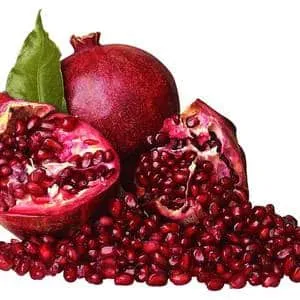
The pomegranate is a fruit-bearing plant from the Punica genus in the Lythraceae family, originating from Asia. Today, it is widely cultivated in the Mediterranean, the Middle East, parts of Asia, and North and tropical Africa.
This subtropical tree can live for 50-60 years, after which its yield declines, and old plantations are replaced. On average, one tree produces 50-60 kg of fruit. The natural ripening period varies: in the Northern Hemisphere, it’s September to February, while in the Southern Hemisphere, it’s March to May.
Note: The fruit’s color doesn’t change as it ripens, making harvest timing tricky. If picked unripe, pomegranates can be stored to mature further under controlled humidity (80%) and temperature (+1…+2°C). However, their quality remains largely unchanged during storage.
About the Fruit
The pomegranate is a juicy, edible fruit whose seeds and juice are consumed, while other parts (peel, bark, and membranes) are used for medicinal purposes. The arils (seed casings) are eaten raw, added to dishes and drinks, or processed into juice.
There are two main species: Punica granatum (common pomegranate) and Punica protopunica (Socotran pomegranate). In Europe, the common pomegranate is most popular. The fruit is orange-sized, with a skin ranging from yellow-orange to deep red, and a sweet-tart flavor. Its chemical composition varies based on ripeness, growing conditions, and storage.
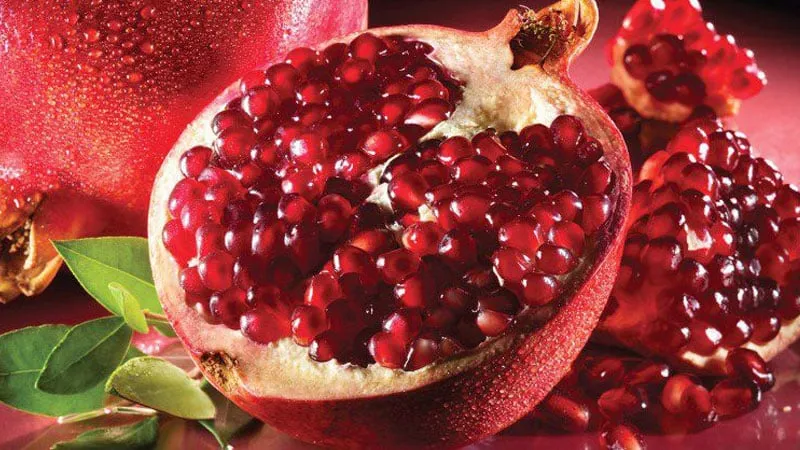
Nutritional Composition, Vitamins, and Minerals
Pomegranates are low in calories—72-80 kcal per 100 g, with 0.7 g protein, 0.6 g fat, and 14.5 g carbohydrates. They are rich in bioactive compounds, including:
- Omega-6 fatty acids
- Vitamin A
- Beta-carotene
- B vitamins: B1, B2, B3, B4, B5, B6, B9
- Vitamin C
- Vitamin E
- Vitamin K
- Macrominerals: potassium, calcium, magnesium, sodium, sulfur, phosphorus, chlorine
- Microminerals: iron, iodine, cobalt, manganese, copper, molybdenum, selenium, fluoride, chromium, zinc
Health Benefits of Pomegranate
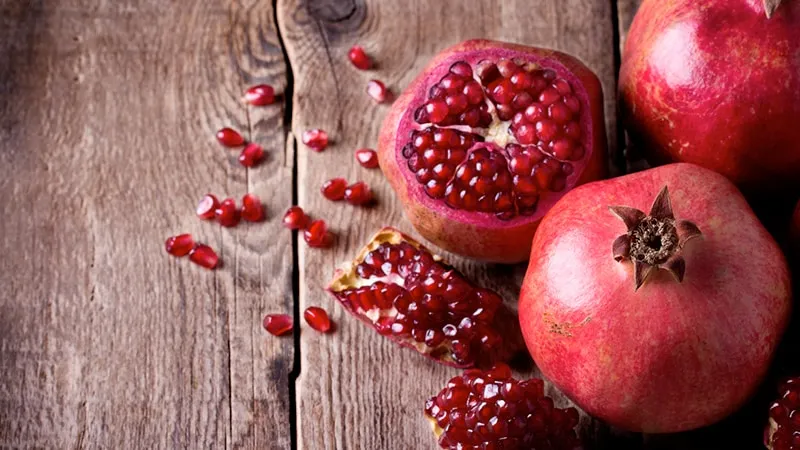
The seeds and juice contain vital nutrients that support overall health:
- Urolithin A: A potent antioxidant that reduces inflammation and lowers cancer risk.
- Retinol (Vitamin A): Slows aging, promotes wound healing, and supports vision and skin health.
- B Vitamins: Enhance nervous system function, memory, and stress resilience.
- Vitamin C: Boosts immunity, strengthens blood vessels, and prevents thrombosis.
- Vitamin E: Maintains skin health, regulates metabolism, and supports cognitive function.
- Amino Acids: Essential for brain function, protein synthesis, and nutrient absorption.
- Fiber: Aids digestion, detoxifies, and supports gut microbiota.
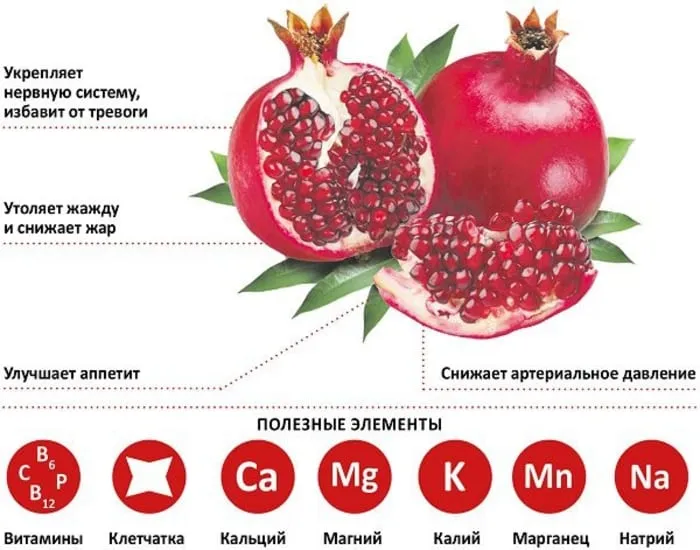
Pomegranate juice is recommended for anemia due to its vitamin K content, which aids red blood cell production. It also benefits heart health, stabilizes blood pressure, and supports post-illness recovery.
For Women

Pomegranates support hormonal balance, skin health, and menopause management. Their antioxidants combat aging, while B vitamins ease menopausal symptoms like hot flashes and mood swings.
During Pregnancy

Key benefits include:
- Vitamin A: Supports progesterone production, crucial for pregnancy.
- Vitamin B6: Alleviates morning sickness.
- Folic Acid: Vital for fetal neural and cardiovascular development.
While Breastfeeding
Pomegranates replenish nutrients post-delivery, enhance immunity, and reduce postpartum depression risk.
For Men
Benefits include:
- Improved prostate health.
- Enhanced fertility and muscle development.
- Increased stamina.
For Children

Supports growth, cognitive function, and immunity. Introduce juice after age 1, diluted with water.
For Seniors
Combats aging, supports bone and heart health, and regulates cholesterol.
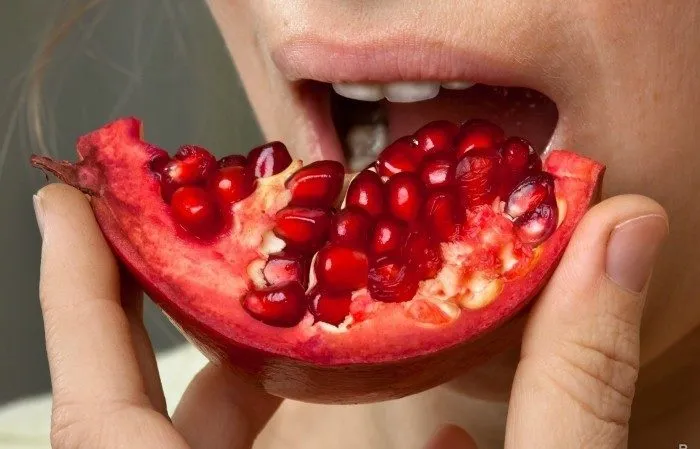
For Diabetics
Low glycemic index (35) and high fiber aid blood sugar control.
Potential Risks and Contraindications
Avoid pomegranates if you have:
- Stomach ulcers or gastritis (acids may irritate).
- Allergies (high allergenic potential).
- Kidney stones or severe renal/liver disease.
Warning: Always rinse your mouth after consuming juice to protect tooth enamel.
How to Eat Pomegranate Properly

Seeds can be eaten if chewed thoroughly. Pair with dairy, lean meats, or salads. Juice should be diluted 1:1 with water.
Peeling Methods

- Cut off the crown, score the skin, and break apart.
- Halve and tap with a spoon to release seeds.
- Soak in water to loosen membranes.
Daily Consumption
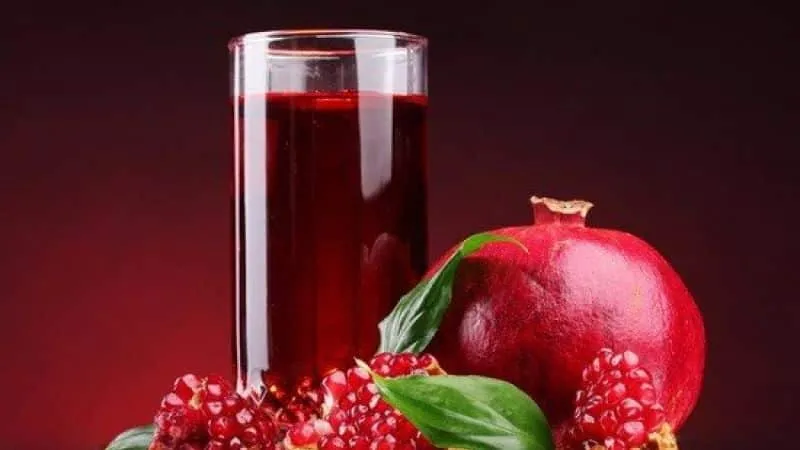
Adults: 1 medium fruit or 200-300 mL juice daily. Children: ¼ to ½ fruit, 2-3x/week.
Best Time to Eat
Morning or afternoon for energy. Avoid on an empty stomach.
Can You Eat Pomegranate Seeds?
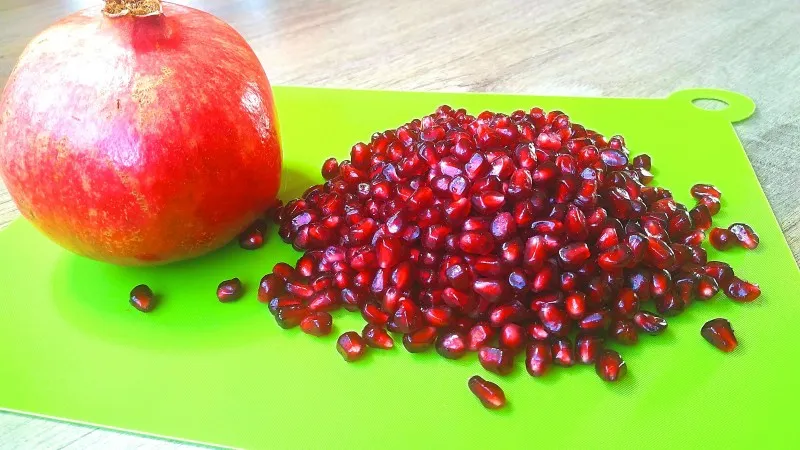
Yes, if chewed well. Whole seeds may cause digestive discomfort.
Conclusion
Pomegranates offer anti-inflammatory, immune-boosting, and heart-healthy benefits. Moderation and proper preparation are key to maximizing their advantages.







